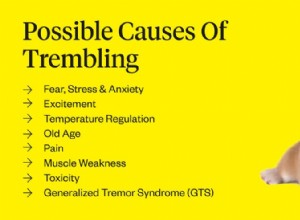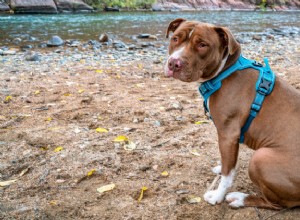犬が常に同じ場所を引っ掻いたり、なめたり、噛んだりしている場合は、ホット スポットがある可能性があります。急性湿性皮膚炎としても知られるホットスポットは、犬に影響を与える皮膚の状態です。治療せずに放置すると、これらの厄介な傷は痛みやかゆみを引き起こし始めますが、適切なケアをすれば、簡単に治療および予防することができます.
犬のホットスポットの原因、症状、利用可能な治療法について詳しく知るために、読み続けてください.
目次:
プロのヒント: ホットスポットは、既存の状態でない限り、一部のペット保険プランでカバーされています.つまり、犬のホット スポット治療のために支払われた自己負担費用が払い戻されるということです。
急性湿性皮膚炎としても知られるホット スポット 、根底にある刺激により炎症を起こした皮膚を引き起こす犬の一般的な状態です。犬がかゆみのあるホットスポットを舐めたり、噛んだり、引っ掻いたりすると、炎症を起こした皮膚が細菌感染や二次的な健康問題を起こしやすくなります.犬はいつでもホット スポットを発症する可能性がありますが、最も頻繁に発生するのは暖かい夏の時期です。そのため、「夏のただれ」として知られることもあります。
ホットスポットは犬の体全体に広がりやすいため、できるだけ早く症状を認識することが重要です。潰瘍自体は人にも他の犬にも伝染しませんが、根本的な原因 (寄生虫や真菌感染症) は種を超えて伝染する可能性があります。そのため、犬の皮膚に異常が見られた場合は、必ず獣医に連絡してください。
最初は、犬のホット スポットは皮膚の小さな赤い斑点のように見えます しかし、傷は数日のうちに急速に拡大する可能性があります.患部がかさぶたになることがあります 、にじみ出る おりもの、ひどい場合は出血 .犬のホット スポットのその他の兆候には、腫れ、脱毛、痛みなどがあります
ホット スポットの外観とサイズは場所によって異なります 、通常、首、顔の腰、または手足が含まれます。急性皮膚炎は犬の体のどこにでも発生する可能性がありますが、この状態は細菌感染しやすい湿った地域で特に流行しています.
犬が特定の場所を絶えず噛んだり引っ掻いたりしている場合、またはかさぶたや炎症を起こしているように見える炎症を起こした皮膚のパッチに気付いた場合は、獣医師に連絡してください.患部が出血している、サイズが大きくなっている、色付きの分泌物がにじみ出ている場合は、獣医に連絡することがさらに重要です。

食物アレルギーは、犬のホットスポットの 50% を占める可能性があります 、最近の見積もりによると、特に何があなたの子犬を悩ませているのかを判断するには、獣医に相談する必要があります.
Other common causes of hot spots on dogs include :
Any underlying condition that triggers excessive licking, scratching, or moisture build-up can cause hot spots on dogs. As little as 10 minutes of chewing is sufficient to create acute dermatitis.
Due to their thick coats, some dog breeds are genetically predisposed to hot spots. A few examples include:
The best treatment for dog hot spots depends on the underlying source of irritation in your specific pet. Your vet will need to identify the underlying cause to treat it effectively and prevent it from recurring. Depending on the case, you may be able to provide your pet with relief using natural hot spot home remedies.
Here’s how to treat hot spots on dogs at home:
Hopefully, your pet’s condition begins to improve, but it’s still wise to visit your veterinarian to understand what caused your dog’s hot spot and how you can prevent them in the future.
If the hot spot does not improve, gets worse, or spreads to other areas, it’s critical to see the vet as soon as possible. Unfortunately, approximately 30% of dogs with hot spots will have some form of skin disease (like a bite wound or deep infection) that requires veterinary treatment, meaning home remedies alone will not suffice.
Your vet will perform a full physical exam and may recommend additional tests, such as an allergy panel or skin scrape to check for parasites. Once they diagnose the underlying cause, they will prescribe a suitable treatment. Most vets treat hot spots with topical medication to control inflammation and decrease itching, and oral antibiotics to treat secondary bacterial infections.
Your vet might also prescribe medicated solutions, wipes, or hot spot sprays to gently clean the affected area daily, as well as an Elizabethan collar to prevent your dog from continually scratching or licking. Depending on the underlying cause, additional medications might be necessary to treat conditions like allergies, ear infections, or flea infestations.

The cost of diagnosing and treating hot spots on dogs will depend on the severity of the lesion and how often it recurs. For instance, if the lesions appear once or twice a year and they remain uncomplicated, the owner might decide to treat such episodes symptomatically without the need to manage an underlying disease. In that case, hot spot treatment will be less expensive, ranging from $40 to $200 .
On the other hand, if more comprehensive diagnostic tests are required, the expense will increase significantly. This is especially true if allergy testing is needed, which might cost up to $2,000 .
Pro Tip: No matter what type of veterinary treatment your pet needs, vet bills can be expensive. However, with the right pet insurance policy, you can protect yourself against unexpected costs and ensure your four-legged friend gets the best care possible.
Once your vet has started treating the hot spot, your dog will likely improve rapidly. It usually takes between three and seven days for a hot spot to dry out and start to heal. Your pet’s fur should start growing back in about two weeks. If your pup is still having issues after a week or two, be sure to get in touch with your vet.
Unfortunately, if your dog has experienced hot spots once, chances are they might get them again. Taking preventive measures like flea control and proper grooming can help decrease the risk of recurrence.
If your pet experiences chronic hot spots, it might be a good idea to speak to your vet about getting your pup tested for food and skin allergies, joint problems, and hypothyroidism.
Good hygiene, regular grooming, allergy management, and flea/tick prevention are all essential to preventing hot spots on dogs . Also make sure your pup is completely dried off after bathing or swimming, especially if they have a double coat or long hair.
If your dog is prone to licking due to stress or boredom, consider increasing their daily exercise or provide them with puzzle toys that will keep them busy and mentally stimulated.
Another way to help prevent hot spots is by using fatty acids supplements. Fish oil is an excellent source of the Omega-3 fatty acids EPA and DHA that have anti-inflammatory properties and promote a healthy skin barrier. Consult your vet for advice on what supplements are best for your dog and the correct dosage.

重要なポイント あらゆる年齢、サイズ、品種の犬は、恐怖、ストレス、不安、興奮、痛みなど、さまざまな理由で震える可能性があります。犬の震えのいくつかの原因は有害ではありませんが、行動の問題を防ぐために訓練に対処する必要があります。他の場合では、震えは、資格のある獣医による診断と治療を必要とするより深刻な状態の兆候です。 興奮、ストレス、痛み、発熱、濡れている、食べてはいけないものを食べているなど、多くのことが毛皮で覆われた友人を震えさせたり震えさせたりする可能性があります。一見心配することもありますが、震える犬は悩みの原因にはならないことがよくあります。基礎疾患やその他の深刻な病気は震えを引き

犬の下痢はよくあることです。状態は、ケースごとに強度、頻度、および期間が異なります。多くの場合、自然にすぐに治りますが、犬の継続的な下痢は、より深刻な健康状態の兆候である可能性があります. この投稿では、犬の下痢のさまざまな原因、懸念の原因を示す兆候、獣医に診てもらう時期について説明します.また、ペットの体調をできるだけ早く回復させるために、犬の下痢の家庭でできる対処法についても説明します。 目次: 犬の下痢とは? 犬の下痢の原因は? 犬の下痢の種類 犬のうんちの違いは何を意味しますか? 犬の下痢を止める家庭薬 犬の下痢で獣医にかかる時期 犬の下痢の治療法 重要ポイント プロのヒン